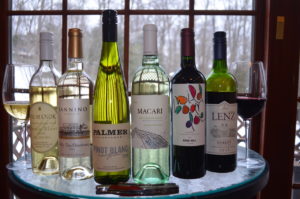
In Europe, the wine-world timeline is measured in centuries and many generations. In the Americas, this same timeline is measured in decades and might include a couple of generations. In Europe, a plot of vineyard-appropriate land might have been bestowed upon a titled baron, count or duke. In the Americas, the plot of vineyard land was probably purchased by forward-thinking parents or maybe grandparents. The state of New York is third in U.S. wine production by volume, behind California and Washington. And although Long Island has only relatively recently entered into the winemaking world, it is a major producer within New York state.
Many of the 57 Long Island wineries began as potato farms, picked up in the 1970s, ”™80s and ”™90s from some hardworking farmer looking to retire. Some grape vines were planted and winemaking skills were developed. It became somewhat clear that the soil of the region combined with the relative temperate weather supported by the Atlantic Ocean, with its nearby warming Gulf Stream and Long Island Sound, could be a gold mine for quality wine production. It takes time for any wine region to hit its stride for several reasons. Long Island wineries began as a fantasy idea without much wine knowledge. Doctors and IBMers adopted that Nike “Just do it” attitude without much industry experience. Of course, even under the best conditions, it takes time and experience to make quality wines. Additionally, discovering the proper grape for each specific location is key. The specific soil types and the micro climate might be perfect for one varietal and almost toxic for another. And finally, it takes time for the vines”™ roots to penetrate to depths necessary for tolerating weather extremes but also for extraction of different soil and rock flavors that will complement that wine.
All the grape-growing literature available says it takes three years minimum to get a proper harvest from a nascent vineyard. But it actually takes decades for proper vine maturity for flavor and terroir extraction from the earth. I traveled to Montefalco in Umbria, Italy, two years ago and tasted many of its Sagrantinos, a bold red wine for which the region is known. I had tasted many of these at a New York-guided tasting a decade earlier and all of them were so tannic they were difficult to taste without food, which helps bond with and soften tannins. I asked several producers in the Montefalco region how their wines became so much better and so mouthfeel-pleasant, and they all said the same thing: The roots of the vines now have proper depth.
About a decade ago I traveled to Long Island and visited a couple of wineries and tasted several other Long Island wines. Everything I tasted was adequate and little more. I was asked recently if I would be interested in receiving six bottles from six different Long Island wineries. I responded with an enthusiastic “yes.” At liwines.com, there are direct links to many of the wineries”™ websites where you can order wine or plan a visit. Each winery has its specific rules. Some allow walk-in tastings. Others require reservations. Some allow buses, limos and vans and others emphatically do not. Some have restaurants and some have overnight accommodations. Familiarizing yourself with the hosts before hand would be beneficial.
The Macari Vineyards on the North Fork of Long Island may be the most beautiful grape-growing estate out there. Situated on an elevated bluff adjacent to Long Island Sound, this cultivated and elegant 500 acres is now being run by two generations working together. The 2020 Macari “Katherine”™s Field” Sauvignon Blanc will stand up to any SB of the world. Flavors of citrus and lemon zest, pineapple, crisp clean fruit with tropical floral notes will greet you. At 12.6% ABV (Alcohol By Volume), lively and lovely, this is a wonderful waterfront wine and a perfect evening “greeter” wine.
The Paumanok Vineyards 2020 Chenin Blanc is dry, yet fruity with lemon citrus and orange flowers with a zingy tartness and a lingering mouthfeel/finish ”” delish. Paumanok wines are made from the grapes grown on its 80-acre plot. Proprietors Charles and Ursula Massoud, along with the Macaris, are some of the original wine producers on the island.
The Sannino Vineyard 2020 Chilly Day Chardonnay is fresh and spicy with notes of finely ground white pepper and is worthy. The Sannino family purchased an existing winery in 2006 and joined the party. Look for this Chilly Day Chardonnay to serve with your next fish meal.
The Palmer Vineyards 2019 Pinot Blanc shows a balanced and pleasant tartness with Meyer lemon notes and a peppery, allspice flavor ”” tasty and satisfying.
The 2015 Lenz Winery Merlot shows dark fruit, blackberry, plum with balanced tannins and great oak texture, meaning the oak presence is felt but does not overtly flavor the wine. Rich and full-bodied, this wine can be opened now or cellared for a decade or more.
And finally I tasted the Rose Hill Vineyards 2019 Wild Boar Doe. This Bordeaux varietal creates a dark fruitiness with an earthy and peppery presence. Mourvèdre (Monastrell in Spain) is often a grape used to add texture and a velvety mouthfeel to the wine. There is none in this wine, but it feels that way. Again, tasty and worthy.
All of these wines are delicious, respectable and well-priced. All the whites retail for around $25 with the two reds at $45 for the Wild Boar Doe and $35 for the Lenz. They can all be consumed on their own or paired with a meal. Virtually all of the wineries are pursuing organic, sustainable and responsible grape-growing practices that are earth-friendly. Welcome Long Island. You have earned your place on the world-wine stage.
Write me at doug@dougpaulding.com.





















